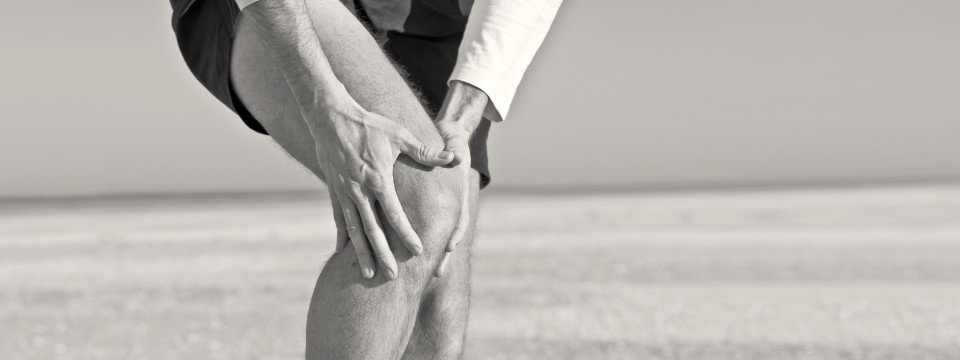Less pain. More life.
Start by checking all of your treatment options for osteoarthritis
The clinical condition, which is related to various types of painful joint damage, has long held a place amongst the most widespread diseases. Today, people of every age are affected by painful osteoarthritis caused by wear, injury or overstraining of the joints.
When the knee joint is affected, for example, patients often suffer from significant restrictions to their mobility and everyday lives. This is a source of frustration for busy and active patients in particular. Efforts to quickly relieve the pain often result in taking increased amounts of pain medication. Potential side effects are simply accepted as a matter of course. Then comes a point at which an operation appears unavoidable in order to quickly restore the patient's former quality of life.

What you should know about osteoarthritis
Osteoarthritis – also known as “joint wear” – is the most prevalent joint disorder in the world. Wear damages or destroys the protective layer of cartilage on the joint to the extent that mobility is reduced and movement is painful.

The alternative to pain relievers
The braces in the Ottobock Agilium line are pain relief you can wear. Perfectly tailored to the various types of osteoarthritis of the knee, they combine suitability for everyday use with a high level of comfort.

Agilium select – which brace suits me best?
Agilium select helps you quickly and easily find the ideal product for you and your needs. Based on our selection criteria, we’ll take you directly to the right brace

Our products for osteoarthritis of the knee
Thanks to the products in the Agilium line, many satisfied patients have been able to resume their regular everyday activities again. Learn more about the individual braces and how they help people with osteoarthritis of the knee.

Osteoarthritis of the knee: what to do?
If knee pain is restricting your quality of life, it’s hard to know what to do. Learn more about the causes of this widespread clinical condition and effective treatment methods – apart from taking pain medication.
Frequently asked questions
-
What is osteoarthritis?
Osteoarthritis is the most common of all joint diseases. It is caused by excessive strain, malalignment or injury. Often, the cartilage in the joint becomes worn out through mechanically inappropriate or excessive strain and this is how the joint is damaged.
-
I currently have early osteoarthritis. Can I stop this disease from getting worse?
It is possible to stop the degeneration of the cartilage and prevent related diseases. You can reduce your risk by, for example
- working to achieve a normal weight
- avoiding alcohol and nicotine
- avoiding excess joint strain
Make sure you get enough physical exercise without putting too much pressure on your joints while doing it. This will improve the flow of nutrients to the cartilage and the evacuation of metabolic waste from the joint. Cycling and swimming, for example, are activities you could explore which are easy on your joints.
If appropriate, have your physician or physiotherapist show you exercises that you can do regularly for your specific type of osteoarthritis. This can help you avoid subsequent orthopaedic problems due to compensatory or poor posture.
When you buy shoes now, make sure that they have soft soles or buffer heels and shock-absorbing insoles. Your joint cartilage will thank you for it!
-
Can osteoarthritis be completely cured?
At the moment, natural regeneration of worn-out cartilage is not possible. So please make sure you get enough physical exercise and avoid possible risk factors such as activities that damage cartilage or long-term overloading of the joint.
-
What are the treatment options?
Treatment for osteoarthritis is personalised and depends on the particular type of osteoarthritis, its cause, stage and symptoms. Your physician will discuss the right type of treatment together with you. The aim of the therapeutic measures is to reduce pain and restrictions to your mobility while also avoiding any subsequent problems.
-
How do I find a brace that’s right for me?
You can get an initial overview of brace options on our website. Your physician or medical supply company can assist you in making the right choice.
-
Should I expect side effects if I wear a brace?
Minor side effects related to the condition of your skin are possible. You should always consult your physician about using a brace.
-
Could a brace be an alternative to taking pain relievers?
Yes, a brace can lead to a reduction of pain and an associated reduction of medicinal pain management.
-
Does a brace replace other measures such as changing my diet or doing exercises?
A brace is a useful addition to other measures, such as changing your diet or targeted movement training. Using a brace can reduce the consumption of pain relievers and delay an operation.
-
Does a brace also help when a joint has already been replaced by an endoprosthesis?
An endoprosthesis is an implant that stays in your body for an extended period and partially or completely replaces a joint. This eliminates the symptoms of osteoarthritis so that, depending on the case, a brace no longer needs to be used. Your physician will explain this to you in more detail.
Downloads

- download 1.40 MB | PDF
Patient information
The patient guide provides general information on osteoarthritis of the knee. It also outlines the symptoms, progression and therapy options for osteoarthritis in the knee as well as helpful tips on what you yourself can do if you have osteoarthritis.
